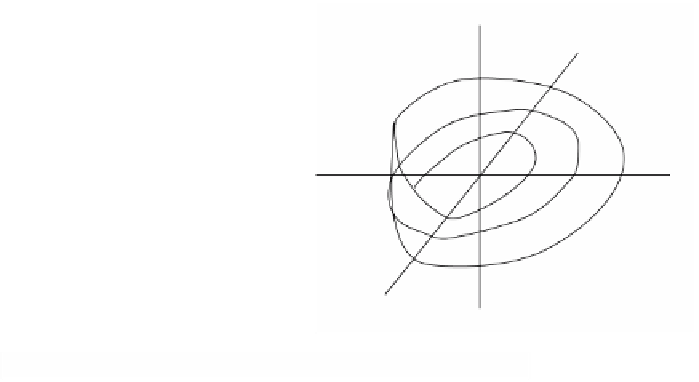Graphics Reference
In-Depth Information
Figure 8.3.
Parameterizing the Moebius strip.
z
y
a
2
u
q
p
q
q
x
-3
-2
-1
1
2
3
-2
()
=
(
)
Fq
,
t
2
cos ,
q
2
sin ,
q
t
,
0
£<
q
2
p
and
-££
1
t
1
,
but in the case of the Moebius strip we need to rotate the line segments about their
center point. When q is zero, we start with a horizontal line segment from 1 to 3 on
the x-axis. As q increases, we start rotating the line segment about its center on the
circle of radius 2 with the top end tilting up toward the z-axis. When q gets to p, the
line segment is vertical. The parameterization is easy to write in vector form. Let
=
(
)
e
q
cos ,sin ,0
qq
and let
u
q
denote the unit vector which, at “time” q, points from
p
q
= 2
e
q
to the point at
the top of the vertically-slanted line segment. Then the parameterization we want is
()
=+
Fq
,t
2
eu
.
t
q
q
It remains to compute
u
q
in terms of q and t. But
u
q
lies on the unit circle in the ver-
tical plane through the origin with basis
e
q
and
e
3
. If it makes an angle a with the
vector
e
q
, then
u
=
cos
a
e
+
sin
a
e
3
.
q
q
Since a = q/2, we are led to the following formula for F:
q
q
q
Ê
Ë
Ê
Ë
ˆ
¯
Ê
Ë
ˆ
¯
ˆ
¯
()
=+
Fq
,
t
2
t
cos
2
cos ,
q
2
+
t
sin
2
sin , sin
2
q
t
,
(8.3)
where 0 £q<2p and -1 £ t £ 1.
Parameterizations are intended to help in the study of a space. They are usually
not of interest by themselves. The idea is that by determining properties of the map
one gets some information about intrinsic properties of the space. As mentioned
earlier, the definition as it stands is really too general to expect something like this to
work unless the map is essentially one-to-one.




